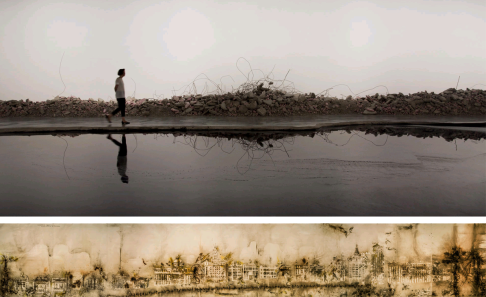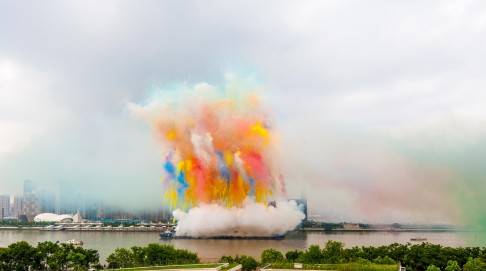
Artist Cai Guoqiang gets more bang for his bucks
Cai Guoqiang's works are often huge, sometimes explosive, but always thought-provoking
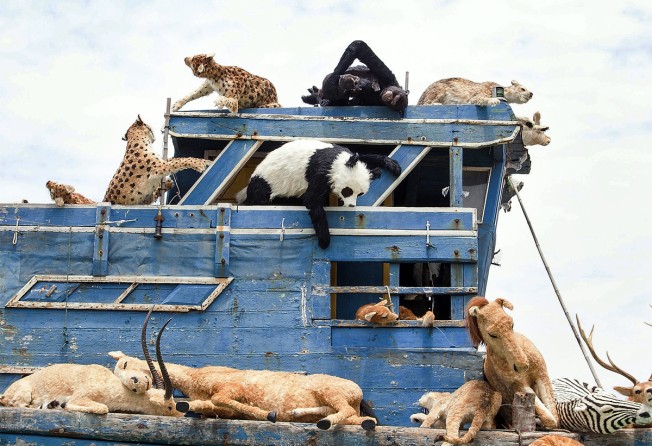

Even if you don't recognise the name Cai Guoqiang, you'll almost certainly have seen his work. He was the man who lit up the opening and closing ceremonies of the Beijing Olympics and Paralympics.
As one of China's most famous contemporary artists, he's known for his use of gunpowder and in the "Bird's Nest" stadium on the auspicious night of August 8, 2008, the declaration that China had spectacularly arrived on the global stage was written with Cai's fireworks.
Exactly six years later, on the afternoon of August 8, 2014, Cai performs a daytime "explosion event" in Shanghai. Pyrotechnic displays have been part of his international artistic repertoire since the 1990s, but his daytime versions only began in 2005, and this is the first one he's executed on the mainland. The idea is to draw attention to China's environmental problems - plus his exhibition, "The Ninth Wave", which opens that same day at Shanghai's Power Station of Art (PSA).
An observer, waiting by the Huangpu River in increasing drizzle (unlike 2008 Beijing, there's no weather modification technology), could be forgiven for wondering if the world really needs another blitzkrieg in this battle-scarred, overheated summer.
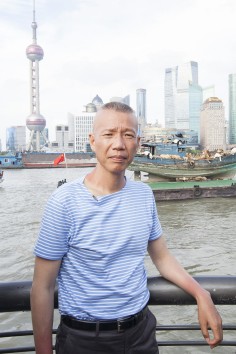
Then the barge on the river bursts into life. Cai's daytime events rely on coloured smoke to illustrate their stories. His Shanghai narrative concerns nature's decline, and is told in three visual chapters: "Elegy", "Remembrance", "Consolation". For eight minutes, the sky becomes a wonderful canvas as he plays with artistic techniques - chiaroscuro, scumbling, impasto - to create vast crows, grasses, chrysanthemums and willows while the air shrieks and a tiny drone flitters about (rather unnervingly) videoing the magnificent effect. It is, as Lars Nittve, executive director of M+ of the West Kowloon Cultural District, who is present, enthuses afterwards, "so painterly".
Unfortunately, no one has thought to inform the public about what's happening. Aware of recent, non-artistic explosion events (factory in Jiangsu, gas pipes in Kaohsiung), panic-stricken locals begin calling the police. As a massive, near-apocalyptic black-and-green cloud descends upon residential blocks, complaints about air pollution ascend into cyberspace. Eventually Cai will spend his evening doing the other kind of fire-fighting: placating state and social media.
The following day, he's at PSA again, for a symposium on art and the environment. If you think the irony could hardly be improved, here's a further level: the event's sponsor is Infiniti, the luxury car brand owned by Nissan. His recent, highly successful, environmentally-themed show at Brisbane's Gallery of Modern Art, which was entitled "Falling Back to Earth" and ended in May, was sponsored by Santos, an Australian oil and gas company. How do these contradictory strands knit themselves together?
Cai, who is 56, has a pleasantly eager face and exhibits distinct grace under pressure, replies through a translator from his New York staff. (Although he's lived in New York since 1995, he doesn't speak English. Before then, he lived in Japan for nine years, where he learned perfect Japanese.) He says society is full of contradictions and this also applies to artists. He says companies such as Infiniti and Santos recognise that problems exist and are working to find a better way but it's unrealistic to tell the entire world not to drive.
He adds that, of course, he draws a line for his art: despite offers, he won't do advertising and he won't be a brand ambassador.
As for the coloured smoke, he says it's not toxic, being specially made from food colouring and fabric dyes. The police permit (evidently a nerve-shredding procedure, during which some pyrotechnicians were briefly detained, although he doesn't refer to this) was granted too late to give Shanghai's population advance warning.
He still sees himself, Cai says, as a little boy who likes his fun and now that everyone knows about the show, it's worked out well. Like the display, the episode has ended in "Consolation"; perhaps it helped that he'd prudently gone to Shanghai's Jingan Temple to light incense sticks beforehand and worn red socks for good luck.
In fact, there had already been an earlier launch, literally, of "The Ninth Wave" exhibition. A boat of that name, built in his hometown of Quanzhou, set sail from Fujian province on July 12 and arrived at PSA five days later, covered in stuffed animals. It's the centrepiece of the show and getting it into the lobby meant disassembling the boat, taking off the front glass doors, then re-assembling it within.
Extreme difficulty is a Cai hallmark. The possibility of ambling up from Quanzhou by, say, Flying Pigeon bicycle isn't on his radar. He may have learned about art from watching his father paint landscapes on matchboxes, but his notions of scale came from his training in stage design at the Shanghai Theatre Academy.
Having said that, The Ninth Wave (the name comes from an 1850 painting by Russian artist Ivan Aivazovsky that depicts shipwrecked mankind) is the weakest element in the show - a giant's toy and cute photo-op. If you want to see effective spectacle featuring animals, try Head On, which consists of 99 wolves flinging themselves at a glass wall. Cai originally created this as a specific response to 20th-century German history for his first solo exhibition in Berlin, in 2006, but the impact has been international. Its reality is breathtaking, far greater than any photo can convey.
He may have learned about art from watching his father paint landscapes on matchboxes, but his notions of scale came from his training in stage design
In another vast gallery (size, clearly, is the reason there's never been a Cai show in Hong Kong, although Nittve's presence suggests future hope) lurks Silent Ink. This was originally intended to be a Sino version of his 2013 work Heritage, which features 99 animals drinking from a sky-blue waterhole and was the centrepiece of the Brisbane show. In Shanghai, he wanted the waters to look polluted but Brisbane wasn't keen on this industrial variation. Cai, however, was determined to dig a hole in the gallery - cue major engineering headache - which he then filled with black ink. By day two of the show, the chemical smell of the ink is almost overpowering.
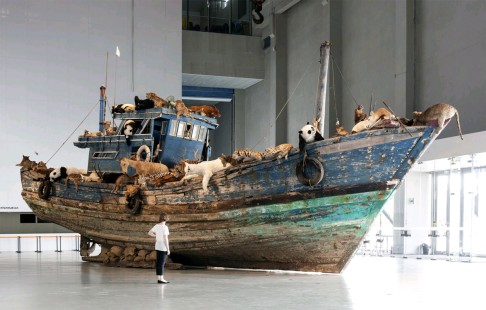
What's significant is that order: excavate, pile up concrete rubble round the edges, find meaning. He loves metaphors, but he says Silent Ink is different in tone, "very abstract", and that, to a certain extent, it relies on its visual impact more than on allegory. You can bring to it what you wish. (This visitor was reminded of the recent Scarlett Johansson film, Under the Skin, in which an alien black lake plays a memorably horrific role.)
If the process is what fascinates Cai, it's also gripping to his public. The show features his gunpowder drawings, including a colossal (27 metres by four metres) depiction of The Bund Without Us - Shanghai overtaken by nature - and Spring, Summer, Fall, Winter, a set of delicate gunpowder drawings on porcelain.
The crowds gathered round videos demonstrating how he achieves such paradoxes are rapt. Cai - tall, Prada-clad, crop-haired - looks like a stylish alchemist, flinging dust to magical effect. People understand the duality of the medium, he says: the creation and the destruction, the celebration and the violence.
Perhaps the most telling moment isn't huge, however. It's in his chronology work, Timeline: a 1996 photo of Cai against the World Trade Centre, explosive smoke issuing from a device in his hands, part of his "Century With Mushroom Clouds" series. Nearby, there's a 2001 photo by his wife, Wu Hong Hong, taken from their New York roof as the towers rained ash on 9/11.
Cai was then in Italy but his daytime events, strangely, grew out of the realisation that horror could happen under a blue sky. He agrees that those who suffered on 9/11 might question the counter-balancing beauty of his explosions, but there is Hiroshima. In awarding him its art prize in 2008, the city invited him to hold a daytime event at the Atomic Dome.
Two months after the Olympics, and with advance warning, black fireworks wrote in a blue sky not of sporting victory but of war's enduring loss.
" Cai Guoqiang: The Ninth Wave" continues at Power Station of Art, 200 Huayuangang Road (near Miaojiang Road), Huangpu, Shanghai, until October 26
